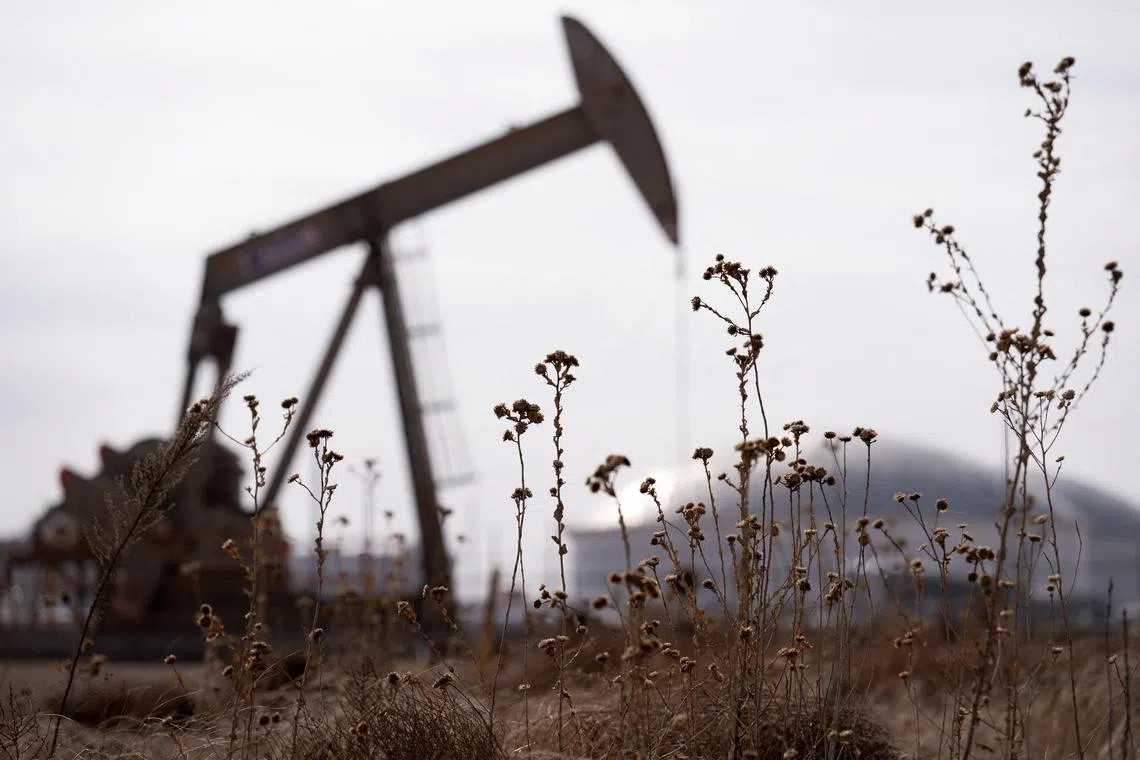[KUALA LUMPUR & JAKARTA] Oil and gas stocks (O&G) across Malaysia and Indonesia are giving up recent gains, following a volatile two-week rally driven by escalating tensions between Israel and Iran that had sent crude prices briefly surging.
The two markets, home to South-east Asia’s most actively traded energy counters, offer a clear snapshot of how regional investors are responding to geopolitical swings in global oil prices.
By Wednesday (Jun 25), the short-lived oil price rally had sharply reversed, with benchmark Brent crude stabilising below US$70 per barrel – a steep drop from the five-month high of US$81.40 reached just two days earlier.
The volatile trend in oil prices was clearly mirrored on Bursa Malaysia. By Wednesday’s closing, the Bursa Malaysia Energy Index, which tracks 23 O&G counters, remained flat at 728.11 points.
This marks a nearly 3.2 per cent decline compared with last Monday’s performance, when the index stood at 752.16 points, its highest in a month.
The abrupt turnaround came after US President Donald Trump announced on Monday that Israel and Iran had agreed to a “complete and total” ceasefire, aiming to end the 12-day conflict. The ceasefire was set to take effect several hours after the announcement, with both sides allowed to complete ongoing military operations before it came into full force.
A NEWSLETTER FOR YOU

Friday, 8.30 am
Asean Business
Business insights centering on South-east Asia’s fast-growing economies.
Major O&G counters experienced mixed trading on Wednesday, with most seeing a downtrend. A notable exception was Petronas Chemicals – the integrated chemical production arm of Malaysia’s national oil company – which edged up 5.8 per cent to RM3.28, after the share price tumbled to five-day low of RM3.04.
Velesto Energy, which provides offshore drilling services, increased around 2.8 per cent to RM0.19. Similarly, integrated technical services firm Dialog Group and offshore support services provider Dayang Enterprise rebounded less than 1 per cent on Wednesday.
Hibiscus Petroleum, the country’s first successful special purpose acquisition company and now a key independent upstream oil and gas producer, was one of last week’s top gainers – on Wednesday, its share price dipped nearly 4.2 per cent to RM1.60, down from RM1.83 on Jun 23.
Meanwhile, offshore support services provider Bumi Armada, Yinson (which specialises in maintenance and hook-up commissioning) and Petron Malaysia Refining and Marketing (a downstream player affiliated with the Philippines’ Petron Corp) all posted declines of between 0.9 per cent and 1.6 per cent on Wednesday.
In Indonesia, key oil producers that have surged in recent days also saw sharp selloffs erasing short-term gains.
IDXENERGY, which tracks energy stocks in Jakarta, closed down 1.8 per cent on Wednesday.
Shares of Medco Energi Internasional (MedcoEnergi), one of Indonesia’s largest private O&G firms, and Energi Mega Persada, a prominent upstream producer, dropped 4.6 per cent and 6.3 per cent respectively.
The drop in MedcoEnergi’s share price has wiped out nearly four trillion rupiah (S$314 million) from its market valuation over the past few days.
Meanwhile, shares of Rukun Raharja, a natural gas infrastructure operator, tumbled 9 per cent to 2,280 rupiah, posting their sharpest decline in a week. The stock had previously climbed to 2,750 rupiah per share on Jun 19, but has since lost momentum amid broader market volatility.
Uncertainties loom
While oil prices have cooled, the underlying geopolitical risks persist.
JPMorgan warns that any escalation, such as a blockade of the Strait of Hormuz, could drive oil prices to US$120 per barrel. However, if the conflict subsides, analysts expect prices to hover near current levels.
The Strait of Hormuz remains a vital chokepoint for global energy trade, handling 34 per cent of seaborne oil exports, 30 per cent of liquefied petroleum gas, and 20 per cent of liquefied natural gas shipments, according to shipbroker Clarksons. Any disruption in this narrow passage could have an outsized impact on global energy prices.
Herald van der Linde, HSBC’s head of Asia equity strategy, highlighted that rising oil prices and heightened risk premiums pose downside risks to Asian equities.
“Korea, Taiwan and Thailand are most vulnerable due to their strong correlation with oil prices, while Hong Kong and Indonesia show less sensitivity,” he told The Business Times.
Malaysia’s economy and currency are also oil-sensitive, given petroleum’s role in fiscal revenues and trade. While O&G companies make up a modest portion of Bursa’s market capitalisation, energy price swings affect cash flows of both importers and exporters.
Azril Rosli, economist at Maybank Investment Bank, said that the oil trade is a main concern for Malaysia as well as Asean, as the region is a net importer. Surging oil prices could worsen trade balances and fuel inflation through higher energy and petroleum-based product costs.
Brian Lee, economist at Maybank Securities Singapore, noted that current oil prices (below US$80) are not yet a major concern for Indonesia, which has budgeted US$82 per barrel for 2025.
“However, sustained prices above US$90 could strain Indonesia’s budget, potentially forcing hikes in subsidised fuel prices as subsidies approach the fiscal limit of 3 per cent of the country’s gross domestic product,” said Lee.
Sector winners

Despite the turmoil, upstream oil producers remain best positioned to benefit from higher crude prices if tensions resurface. Upstream service providers with exposure to maintenance works are expected to demonstrate earnings resilience in coming quarters.
Macquarie Capital’s head of Thailand Research Kaushal Ladha anticipates that upstream producers and refineries will benefit the most, especially if China’s reliance on Iranian crude is disrupted, tightening regional supply and boosting refining margins.
In Indonesia, Ladha highlighted MedcoEnergi as a winner due to its exploration and production activities. Geopolitical risk premiums for crude directly improve earnings for these companies, though most Asian crude grades see limited premiums over benchmarks.
In Malaysia, CGS International analyst Raymond Yap said upstream players such as Hibiscus Petroleum and Dialog are expected to benefit from higher oil prices, with CGS International maintaining an “overweight” rating on the sector.
Hong Leong Investment Bank raised its average Brent oil price forecast for 2025 to US$67 per barrel, citing increased geopolitical risk, and expects upstream activities – especially exploration and drilling – to benefit firms such as Hibiscus Petroleum and Velesto Energy.
As for downstream players, including chemical producers, Macquarie’s Ladha said they may face margin pressure from increased feedstock volatility, with integrated players experiencing mixed effects.
CGS International shared a similar view, issuing “reduce” recommendations for related companies such as Petronas Dagangan, Petronas Chemical, and Lotte Chemical Titan.
Risks

Sector downside risks include lower oil prices if Iran sues for peace, Opec+ (the Organization of Petroleum Exporting Countries and allies) overproduces, or global oil demand declines amid trade pressures, such as potential US “Liberation Day” tariffs, said analysts.
Lim Sin Kiat, senior equity analyst at Kenanga Research, expects the current tensions to ease, with oil prices trending lower in late 2025 as Opec+ retains ample spare capacity. He sees a US$90 per barrel scenario as unlikely, with de-escalation as the base case.
Rully Arya Wisnubroto, chief economist and head of research at Mirae Asset Sekuritas, expects short to medium-term volatility to remain elevated, with energy prices and demand for safe-haven assets likely to stay high.
“This situation may trigger significant foreign capital outflows from the Indonesian stock market, especially from stocks with high foreign ownership,” he told BT.


